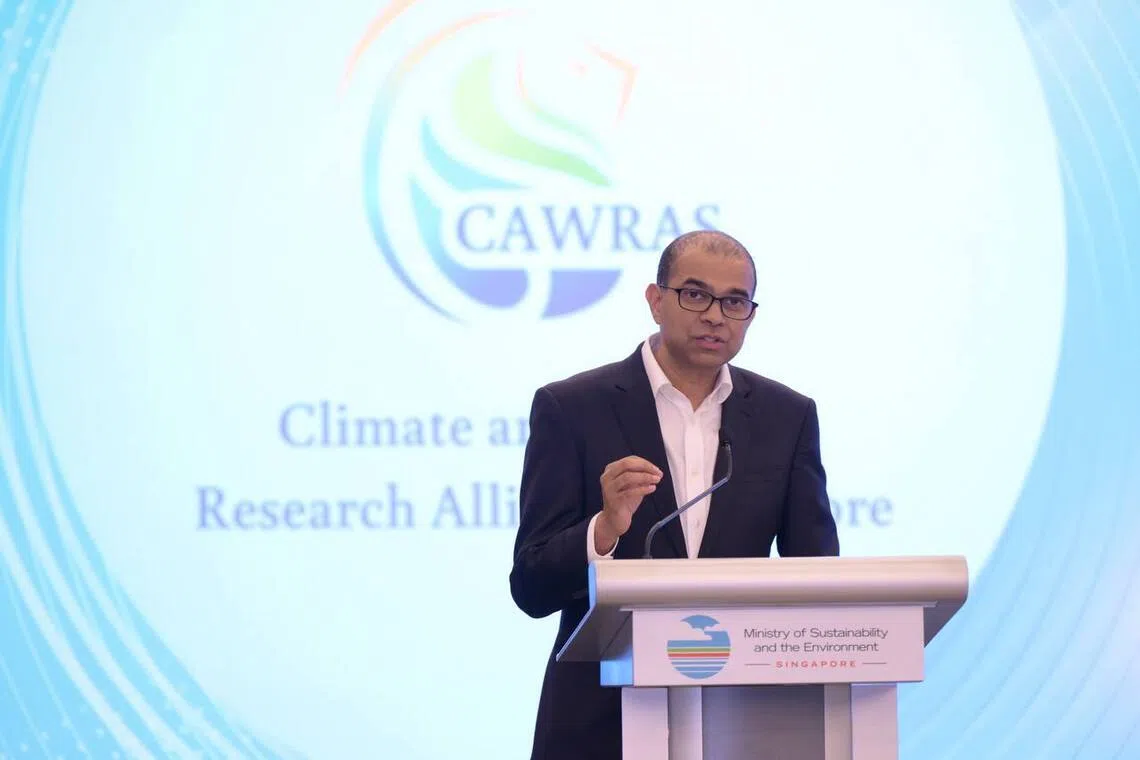10 research projects to improve weather forecasts in Singapore and region under new alliance
Sign up now: Get ST's newsletters delivered to your inbox

While it is already challenging to accurately forecast the weather in the tropics, climate change will cause weather events to become more erratic.
ST PHOTO: LIM YAOHUI
Follow topic:
- Singapore launches Climate and Weather Research Alliance with $25 million to fund 10 projects improving weather forecasting using tech.
- The alliance aims to address erratic weather from climate change including Sumatra squalls, with better localised predictions for hazards.
- The collaborative effort enhances weather resilience, benefiting sectors like aviation, and leverages AI, data, and high-performance computing.
AI generated
SINGAPORE – Using high-tech tools, scientists in Singapore will one day be able to predict a thunderstorm over a specific neighbourhood days in advance – rather than just in minutes or hours today – and provide early warnings of hazardous heat and flash floods.
These are among 10 research projects that will be undertaken to improve weather forecasting here and in South-east Asia, under a new alliance to strengthen climate and weather science.
While it is already challenging to accurately forecast the weather in the tropics – due to the complex interplay of large-scale and local weather patterns – climate change will cause weather events to become more erratic.
On Sept 5, the National Environment Agency (NEA) launched the Climate and Weather Research Alliance Singapore, a multi-institute platform that also aims to grow a talent pool of climate scientists.
The 10 projects are the backbone of the new alliance and will be funded under a $25 million research programme announced in early 2025.
Speaking at the launch of the alliance, Senior Minister of State for Sustainability and the Environment Janil Puthucheary noted that maritime South-east Asia is the “engine room” of the world’s climate. The region influences monsoons and the warming El Nino climate phenomenon, for example, with far-reaching global impacts.
“Yet, scientists have found that the climate and weather of our region are challenging to model and predict due to the complex interplay of land-water interactions, as well as the rapid and unpredictable nature of local weather,” said Dr Janil. He cited a severe Sumatra squall that swept through Singapore in September 2024. It brought a deluge and wind gusts that affected more than 300 trees islandwide, toppling a number of them in less than two hours.
A Sumatra squall is a line of thunderstorms that develops over the Indonesian island of Sumatra or the Strait of Melaka. Scientists do not fully understand how they form.
In the tropics, humid air and its upward movement through convection leads to frequent rain showers and thunderstorms in the region. These events typically develop and dissipate quickly, often within one or two hours. Light breezes also make it difficult to predict the movement of small-scale storms.
Due to the short lifespan of these weather events, computer models tend to be inadequate in accuracy and in providing lead time.
The new alliance – formed by NEA, A*Star, Nanyang Technological University (NTU) and National University of Singapore (NUS) – with its $25 million Weather Science Research Programme fund aims to fill these gaps. Its efforts come as advances in technology, from artificial intelligence (AI) to advanced monitoring tools, present new opportunities to improve weather prediction, said NEA.
In one project, Professor Matthias Roth from the NUS geography department and his team will create a forecasting system that can predict extreme weather – such as intense rainfall or heat stress – at the neighbourhood level.
Prof Roth said the aim is to provide highly localised forecasts – from minutes up to a couple of days in advance – to help residents prepare for potential events such as intense rainfall or flash floods.
His research also aims to find out how buildings, dense urban environments and greenery can influence local weather.
“Despite their proximity, Changi can experience torrential rain while downtown remains dry, highlighting the stark contrast in weather patterns,” he said.
In a separate project, Dr Koh Wee Shing from the A*Star Institute of High Performance Computing will combine 30 years of weather data from the region and advanced modelling to construct solid historical records, which can be key inputs for future predictions.
Another project, led by Dr Xiang Shili from the A*Star Institute for Infocomm Research, aims to improve the forecasts of hazardous events, such as intense rain, strong winds and lightning, with the help of AI and machine learning.

Senior Minister of State for Sustainability and the Environment Janil Puthucheary at the launch of the Climate and Weather Research Alliance Singapore, a multi-institute platform that also aims to grow a talent pool of climate scientists, on Sept 5.
ST PHOTO: NG SOR LUAN
“This project will improve our ability to forecast hazardous weather events that impact daily activities and operations in Singapore. This research will contribute to more accurate and timely weather warnings, helping to enhance Singapore’s weather resilience,” added NEA.
Sectors such as the military, maritime and aviation are also in need of more reliable weather forecasts.
Noting that Changi Airport handles about one flight every 80 seconds, Dr Janil said: “Key aviation stakeholders... are heavily reliant on good, timely weather predictions for efficient and safe air traffic management and airport operations.”
Professor Dale Barker, director of the Centre for Climate Research Singapore, said: “Being able to predict turbulence... impacts where aircraft are going to fly in the next one or two days. That’s critical information.”
The 10 projects will be supported by a new test bed in A*Star that will give the scientists access to weather datasets, advanced modelling technology and supercomputers. Each project will take up to five years to complete.
Each institute brings its own expertise to the alliance, said Dr Janil, who is also Senior Minister of State for Education. He noted that NUS has developed strengths in areas related to urban climate and AI, while NTU has built a track record in earth and environmental sciences. A*Star has expertise in high-performance computing.
Beyond weather prediction, Dr Janil noted that the alliance has the scope to narrow and sharpen climate and sea-level projections down to a few decades or even months.
Currently, Singapore’s third national climate change study – released in 2024 – has made climate projections over longer timescales, mainly to paint scenarios of what is likely to happen in 2050 and 2100.
On building talent, Prof Roth said NUS is exploring if it can offer bachelor’s and master’s degree programmes in weather and climate science. Currently, the university offers a minor in meteorology and climate science, the first such course in Singapore.
On the demand for more weather scientists, Prof Barker quipped: “I joked that if 100 weather and climate scientists dropped on the planet tomorrow, they would have jobs within a week.”
He said: “The key challenge is supply. We have to convince young students who may be attracted by the IT or finance sector that weather and climate science impacts you, your family and the generations to come.”
The alliance’s capabilities will be housed in a new campus building at NUS, said Prof Roth, which will be dedicated to all sustainability and climate-related research churned out by the university.
He added that this “sustainable and resilient building” is expected to be up and running by 2027 or 2028.


